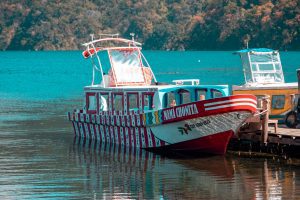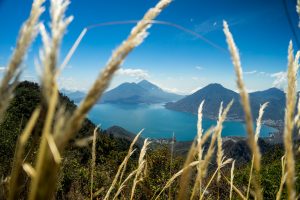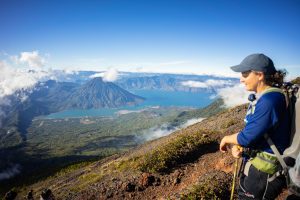“When should I visit Lake Atitlán?” ranks among the most common questions I hear from travelers planning their Guatemala trips. The answer depends entirely on your priorities: guaranteed sunshine, minimal crowds, rock-bottom prices, or specific activities. After fifteen years living at the lake and hosting over 1,000 travelers, I’ve watched every season deliver excellent experiences for visitors.
Lake Atitlán experiences two main seasons: dry (November-April) and rainy (May-October). The nuances within each matter significantly for trip planning. This guide breaks down weather patterns, crowd levels, pricing, and activities month by month to help you choose dates that match your travel style and priorities.
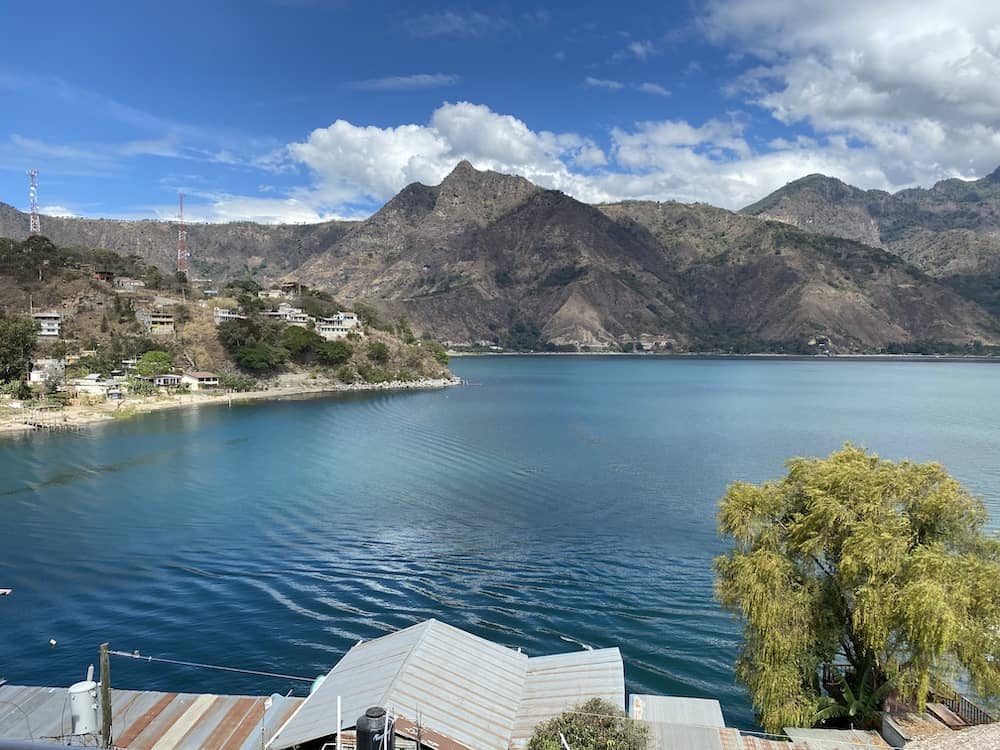
Table of Contents
- Lake Atitlán Climate: What You Need to Know
- Lake Atitlán Weather by Month
- Best Time to Visit Lake Atitlán by Activity
- Best Time to Visit Based on Your Travel Style
- What to Pack for Lake Atitlán by Season
- Lake Atitlán Festivals and Events Calendar
- FAQ
Lake Atitlán Climate: What You Need to Know
Lake Atitlán sits at 1,500 meters (5,000 feet) elevation in Guatemala’s western highlands. This volcanic crater location, surrounded by three towering volcanoes (San Pedro, Tolimán, and Atitlán), creates microclimates that affect weather patterns throughout the year. Pacific Ocean influence brings afternoon winds and seasonal rainfall that follows predictable patterns.
Two Main Seasons
Dry Season (November-April) delivers what most travelers picture when planning a lake vacation. Clear blue skies dominate with minimal rainfall—essentially zero precipitation December through March. Cool mornings and evenings hover around 10-15°C (50-59°F), warming to pleasant 20-25°C (68-77°F) afternoons. Visibility stays excellent for volcano photography and hiking. Strong afternoon winds develop, especially March and April, making boat crossings choppier but creating ideal paragliding conditions.
This period is the peak tourist season. Higher prices (25-50% above the rainy season) accompany reliable weather, and popular towns like San Pedro and Panajachel fill with international visitors and Guatemalan vacationers during holidays.
Rainy Season (May-October) follows predictable afternoon thunderstorm patterns rather than all-day downpours. Mornings typically start sunny and beautiful, perfect for volcano hikes, boat rides, and cultural activities. Clouds build through midday, with rain usually falling between 2-6pm. Most storms pass within 1-3 hours. The landscape transforms into lush, vibrant green. Humidity increases noticeably compared to dry season’s crisp air.
Tourist numbers drop dramatically, creating an authentic local atmosphere. Prices fall 30-40% below peak season rates. All-day rain rarely occurs unless there is a tropical storm in the region. For travelers who can schedule activities for mornings and embrace afternoon downtime, the rainy season offers exceptional value without sacrificing the Lake Atitlán experience.
Year-Round Temperature Consistency
Lake Atitlán maintains pleasant temperatures throughout the year:
- Daytime highs: 20-25°C (68-77°F)
- Nighttime lows: 10-15°C (50-59°F)
- Warmest month: March (up to 27°C / 81°F)
- Coolest months: December-January (down to 10°C / 50°F at night)
The highland elevation keeps temperatures cooler than Guatemala’s coastal regions but warmer than high-altitude destinations like Quetzaltenango. You’ll need layers for cool mornings and evenings year-round, but never heavy winter clothing.
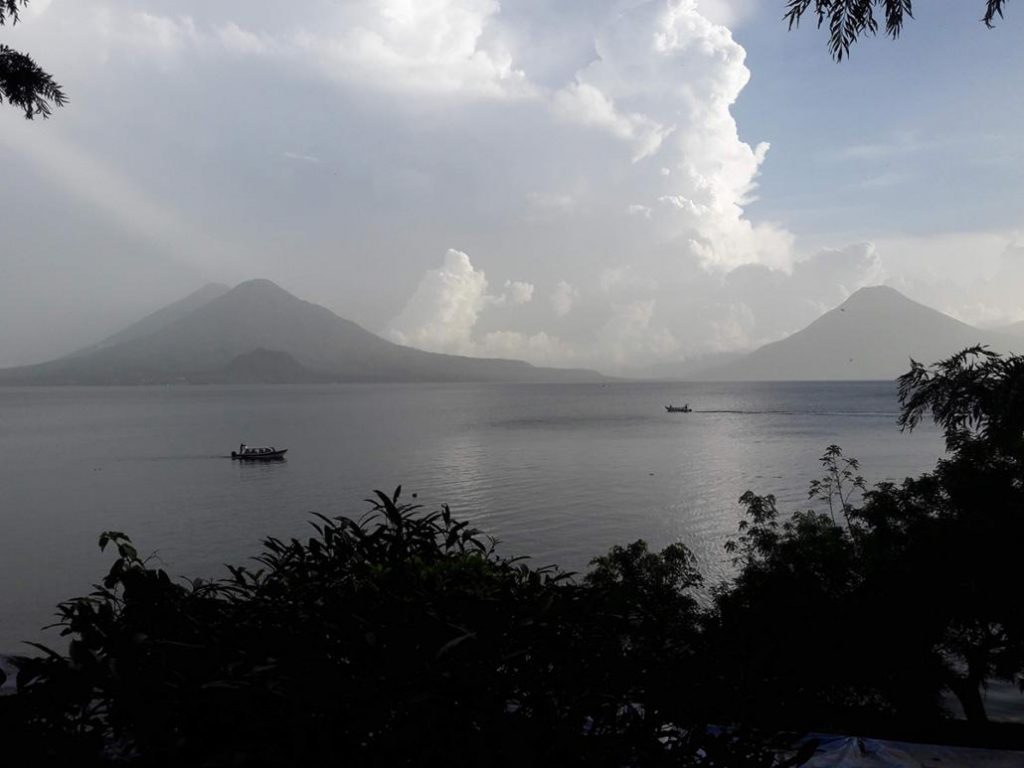
Rainfall Patterns
- Driest months: December-March (less than 10mm monthly rainfall)
- Wettest months: June, September-October (150-200mm monthly)
- Transition periods: April-May, November (variable and unpredictable)
The real variable affecting your trip isn’t temperature—it’s whether you experience predictable afternoon showers or consistently dry days, and whether you’re sharing the lake with crowds or enjoying peaceful solitude.
For comprehensive Lake Atitlán planning beyond timing, see our complete travel guide.
Lake Atitlán Weather by Month
Understanding each month’s specific conditions helps match your visit to your priorities and constraints.
January
Weather: Peak dry season excellence. Clear blue skies dominate with minimal rain (less than 5mm monthly). Cool mornings require light jackets, while warm sunny afternoons invite t-shirts and shorts. Excellent visibility makes volcano photography spectacular from any lakeside vantage point.
Temperature: Lows 10-12°C (50-54°F), Highs 23-25°C (73-77°F)
Crowds: Very High during the first week (Christmas/New Year overflow), then High through month’s end
Prices: Peak during first two weeks, then High
Pros: Virtually guaranteed sunshine every day. Perfect conditions for volcano hiking with dry trails and clear summit views. Best month for photography with sharp light and crystal-clear visibility. All activities operate fully without weather concerns.
Cons: Expensive accommodation, especially the first two weeks when hotels maintain holiday pricing. Popular towns feel crowded with international tourists. Advance booking essential for quality accommodation—waiting until arrival means settling for whatever remains available.
Best for: First-time visitors wanting weather certainty, families constrained by school schedules, photographers, serious volcano hikers prioritizing summit visibility.
February
Weather: Continued dry season reliability. Similar conditions to January but with slightly warmer afternoons as the season progresses. Zero rain expected throughout the month. Clear skies remain standard. Light winds begin building toward March’s stronger patterns, though boat crossings stay comfortable.
Temperature: Lows 11-13°C (52-55°F), Highs 24-26°C (75-79°F)
Crowds: High
Prices: High
Pros: Reliable dry weather continues without January’s peak holiday pricing. Slightly fewer tourists than December-January, though still busy. Excellent for all outdoor activities from kayaking to hiking. Clear volcano views persist throughout the month.
Cons: Prices remain elevated compared to shoulder seasons. Popular spots stay busy despite the post-holiday decrease. Limited availability for spontaneous travel—booking ahead is still recommended.
Best for: Travelers wanting guaranteed good weather, digital nomads settling in for extended stays, yoga retreats capitalizing on dry season comfort.
March
Weather: Late dry season transitioning toward April’s windier patterns. Mostly dry with perhaps 1-2 light rain days toward month’s end signaling the approaching transition. Temperatures warm to the year’s peak. Afternoon winds increase noticeably, particularly for boat crossings between towns. Humidity begins rising slightly from the bone-dry winter months.
Temperature: Lows 12-14°C (54-57°F), Highs 25-27°C (77-81°F) – warmest month of the year
Crowds: High, with Very High spike during Semana Santa if Easter falls in March
Prices: High, spiking to Peak during Semana Santa week
Pros: Warmest month makes swimming most enjoyable. Still predominantly dry weather. Afternoon winds create excellent paragliding conditions. Flowers bloom throughout hillside villages as nature prepares for coming rains.
Cons: Increasingly windy afternoons make boat crossings between towns choppy and sometimes uncomfortable. Semana Santa week (Holy Week before Easter, dates vary yearly) brings Guatemala’s biggest holiday crowds with prices spiking 50-100% and advance booking essential. Dust accumulates after months without rain.
Best for: Paragliding enthusiasts, warm weather seekers who enjoy swimming, travelers okay with occasional wind affecting boat transportation.
Note: Semana Santa timing varies but typically falls late March or early April. Expect Guatemalan families flooding the lake, premium pricing, and authentic religious processions throughout indigenous villages during this week.
April
Weather: Dry season officially ending with transition clearly underway. Increasingly warm and humid conditions. Afternoon winds reach peak strength—the windiest month for boat travel. First real rain showers appear late in the month, though mornings generally stay sunny. Weather becomes more unpredictable than previous months.
Temperature: Lows 13-15°C (55-59°F), Highs 25-27°C (77-81°F)
Crowds: High during early month if Semana Santa falls in April, then dropping to Medium late month
Prices: Peak during Semana Santa, then Moderate as the month progresses
Pros: Excellent shoulder season opportunity after Easter week passes. The landscape remains relatively green before dry months take full effect. Prices drop significantly post-Semana Santa. Perfect paragliding month due to strong, consistent winds. Better value than January-March for similar (though slightly less predictable) weather.
Cons: Windiest month creates rough afternoon boat crossings—consider timing travel between towns for calmer mornings. Weather unpredictability increases—could remain very dry or see the rainy season starting early. Hot and humid conditions are less comfortable than cooler winter months. Dusty before cleansing rains begin.
Best for: Paragliders experiencing peak season, budget travelers visiting after Easter for shoulder season savings, flexible travelers comfortable with variable weather patterns.
May
Weather: Rainy season officially begins though not every afternoon brings storms yet. Expect rain 3-5 days per week, concentrated in late afternoon hours between 2-6pm. Mornings remain predominantly sunny and beautiful—perfect for scheduling activities. The landscape transforms rapidly to lush, vibrant green as vegetation responds to moisture. Dramatic difference from April’s dry brown hillsides.
Temperature: Lows 14-16°C (57-61°F), Highs 24-26°C (75-79°F)
Crowds: Medium, dropping significantly from April
Prices: Moderate
Pros: Excellent shoulder season value as tourist numbers plummet. Prices drop 20-30% from peak season rates. The landscape becomes incredibly green and photogenic. Mornings provide perfect conditions for all activities from volcano hikes to cultural workshops. Afternoon rain cools temperatures pleasantly. Wildflowers bloom throughout villages and hillsides. Authentic local atmosphere returns.
Cons: Afternoon rain requires planning around weather windows. Rain gear becomes essential. Some tourists avoid purely based on “rainy season” label despite excellent morning conditions. Humidity increases noticeably from dry season crispness.
Best for: Budget travelers seeking value, photographers wanting lush green landscapes, flexible travelers who can schedule activities for mornings and appreciate afternoon downtime.
June
Weather: Full rainy season establishment. Afternoon thunderstorms occur most days—expect rain 5-6 days weekly, typically 2-6pm. Mornings usually start sunny, though cloud cover builds earlier than May. One of the wetter months alongside September-October. Heavy downpours are possible but generally pass within 1-3 hours rather than lasting all day.
Temperature: Lows 14-16°C (57-61°F), Highs 23-25°C (73-77°F)
Crowds: Low to Medium
Prices: Budget to Moderate
Pros: Very quiet atmosphere with minimal international tourists. Excellent prices running 30-40% below peak season. Absolutely gorgeous lush scenery. Mornings still provide great activity windows. Easy to secure last-minute accommodation without advance planning. Authentic local atmosphere dominates without tourist crowds.
Cons: Rain occurs almost daily, though timing remains predictable. Some dirt roads around smaller villages become muddy. Laundry takes longer to dry in humid conditions. Indoor afternoon activities needed—reading, working, or relaxing at accommodation.
Best for: Budget travelers maximizing savings, those specifically wanting to avoid crowds, flexible long-term visitors who can structure days around morning activities, digital nomads who work afternoons while rain falls.
July
Weather: Rainy season continues but often experiences “canícula”—a mid-summer dry spell when rain pauses for 1-2 weeks. This phenomenon doesn’t occur every year, making July unpredictable. Generally less rain than June, with showers expected 3-4 days weekly rather than daily. Still expect afternoon timing for any rain.
Temperature: Lows 14-16°C (57-61°F), Highs 24-26°C (75-79°F)
Crowds: Medium as summer vacation travel season brings tourists back
Prices: Moderate
Pros: Canícula dry spell provides bonus good weather windows in some years. Summer vacation period increases activity options and tour availability. The landscape remains lush and beautiful. Better weather odds than June while maintaining reasonable prices. Moderate crowds feel livelier than June’s emptiness without peak season overwhelming.
Cons: Weather unpredictability increases—canícula doesn’t happen every year. More tourists than May-June means slightly higher prices. Still technically a rainy season despite the potential dry spell.
Best for: Summer travelers with school-age children, those wanting rainy season prices without heaviest rainfall, visitors seeking balance between crowds and solitude.
August
Weather: Similar patterns to July with the rainy season persisting but often milder than earlier summer months. Afternoon showers occur 3-5 days weekly. Canícula effect may continue into early August some years. Mornings typically remain clear and activity-friendly.
Temperature: Lows 14-16°C (57-61°F), Highs 24-26°C (75-79°F)
Crowds: Medium
Prices: Moderate
Pros: Decent weather despite rainy season classification. Summer vacation activities and tours fully operational. Prices remain reasonable compared to the dry season peak. The landscape maintains a beautiful lush appearance. Local festivals occur in some villages during August.
Cons: Must continue planning around potential afternoon rain. Not as cheap as the May-June shoulder season. Weather less predictable than December-March dry season certainty.
Best for: Summer family travelers working around school schedules, digital nomads enjoying comfortable long-term living costs, travelers wanting balanced pricing and weather.
September
Weather: Wettest month of the entire year. Expect rain 6-7 days per week with heavy afternoon thunderstorms common. While mornings usually start sunny, rain can begin earlier—noon rather than the typical 2pm start. Occasional all-day rain does occur, though still relatively rare. Very high humidity throughout the month.
Temperature: Lows 14-16°C (57-61°F), Highs 23-25°C (73-77°F)
Crowds: Low—the quietest month for international tourism
Prices: Budget—lowest prices of the entire year
Pros: Rock-bottom prices running 40-50% below peak season. Virtually no tourists create a deeply authentic local experience. Incredibly lush green scenery at peak vibrancy. Extremely easy last-minute bookings with negotiable rates. Excellent for extended stays with monthly accommodation rates available. Dramatic storm light creates interesting photography opportunities.
Cons: Most rain of any month significantly limits outdoor activity windows. Many outdoor pursuits become challenging or impossible. Some businesses reduce hours or close temporarily during the slowest period. Muddy conditions throughout. Can feel isolated if seeking a social backpacker scene.
Best for: Serious budget travelers prioritizing savings above all, long-term visitors negotiating monthly rates, those specifically seeking solitude, photographers capturing dramatic storm landscapes and lighting.
October
Weather: Second wettest month alongside September. Similar heavy afternoon storm patterns with rain expected 5-6 days weekly. Late October shows early transition signs as the rainy season begins winding down toward November’s shift. The first three weeks remain quite wet before improvement.
Temperature: Lows 13-15°C (55-59°F), Highs 23-25°C (73-77°F)
Crowds: Low
Prices: Budget
Pros: Continued very cheap pricing. Minimal tourists maintain an authentic atmosphere. Late October weather begins improving as transition approaches. The landscape remains at peak lushness and green vibrancy. Good availability for November bookings during this planning period.
Cons: First three weeks quite wet with significant rainfall. Limited outdoor activity options during wettest periods. Some tourist services remain reduced from September slowdown.
Best for: Budget travelers, visitors targeting late October for improving conditions, long-term residents enjoying low-season pricing and peaceful atmosphere.
November
Weather: Critical transition month as rainy season definitively ends. Early November still sees afternoon showers 2-4 days weekly. Late November becomes reliably dry with clear skies returning. Perfect weather establishes by Thanksgiving week. The landscape retains lush green character from recent rains while skies clear beautifully.
Temperature: Lows 11-13°C (52-55°F), Highs 23-25°C (73-77°F)
Crowds: Low early month, increasing to High by Thanksgiving week
Prices: Budget early month, rising to Moderate and then High late month
Pros: Best value month overall—early November combines improving weather with still-low prices and minimal crowds. The landscape looks stunning with green hills and clearing skies. Late November delivers perfect weather before December holiday rush. Fewer crowds than peak months even during Thanksgiving week. Strategic timing allows excellent conditions without peak pricing.
Cons: Weather remains somewhat variable early month—could see rain or sunshine depending on specific week. Prices rise steadily through the month as the dry season approaches. Thanksgiving week sees American tourists increase, though not overwhelming.
Best for: Value seekers visiting the first two weeks for optimal price-weather combination, travelers wanting great weather without peak crowds in late November, strategic planners timing between seasons.
Insider tip: The first two weeks of November represent the sweet spot combining improved weather, low prices, few tourists, and beautiful green landscapes.
December
Weather: Peak dry season arrives definitively. Clear, sunny days dominate with zero rain expected. Cool evenings and mornings contrast with warm, pleasant afternoons. Perfect weather for all activities without exception. Excellent volcano visibility from every lakeside viewpoint.
Temperature: Lows 10-12°C (50-54°F), Highs 23-25°C (73-77°F)
Crowds: High becoming Very High during Christmas week and New Year
Prices: High becoming Peak (Christmas/New Year spike 50-100% above normal rates)
Pros: Perfect weather conditions. Festive holiday atmosphere with Christmas decorations throughout villages. All activities available without weather constraints. Clear skies guarantee excellent photography. Holiday celebrations in indigenous villages offer cultural experiences.
Cons: Expensive, especially the final two weeks when holiday pricing takes effect. Very crowded during Christmas and New Year weeks. Advance booking essential—book 2-3 months ahead for holiday weeks. Hotels enforce minimum night stays during holidays, often 3-5 nights minimum.
Best for: Families constrained by school winter break schedules, travelers wanting guaranteed perfect weather, Christmas holiday travelers seeking festive atmosphere.
Strategic timing: Visit the first two weeks of December for perfect weather before peak holiday prices and overwhelming Christmas/New Year crowds arrive.
For detailed budget considerations across different seasons, see our complete cost breakdown guide.

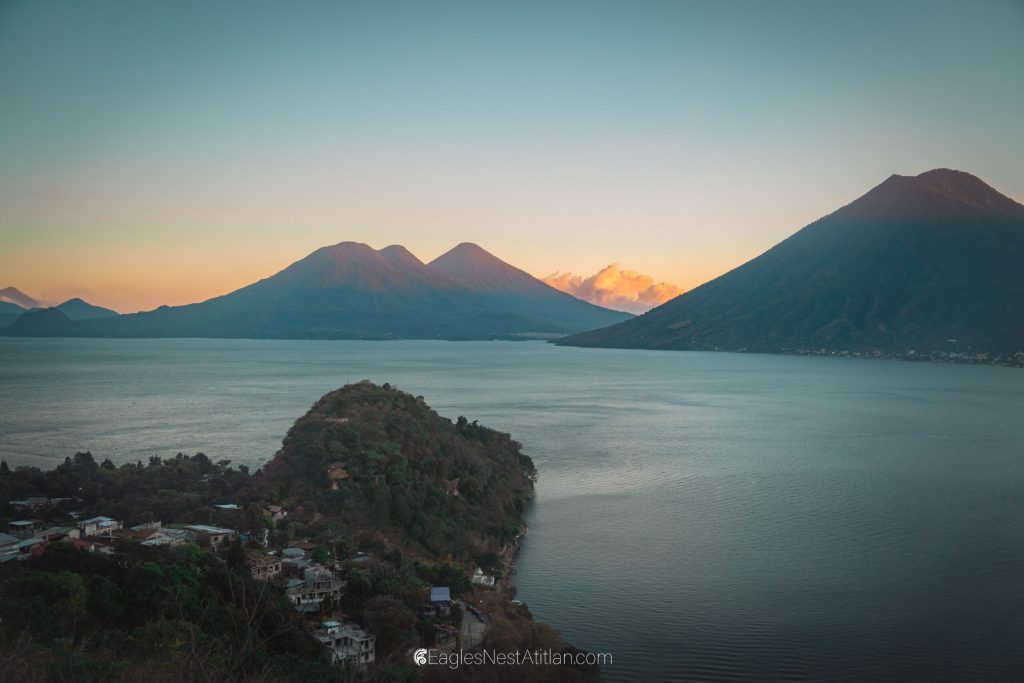
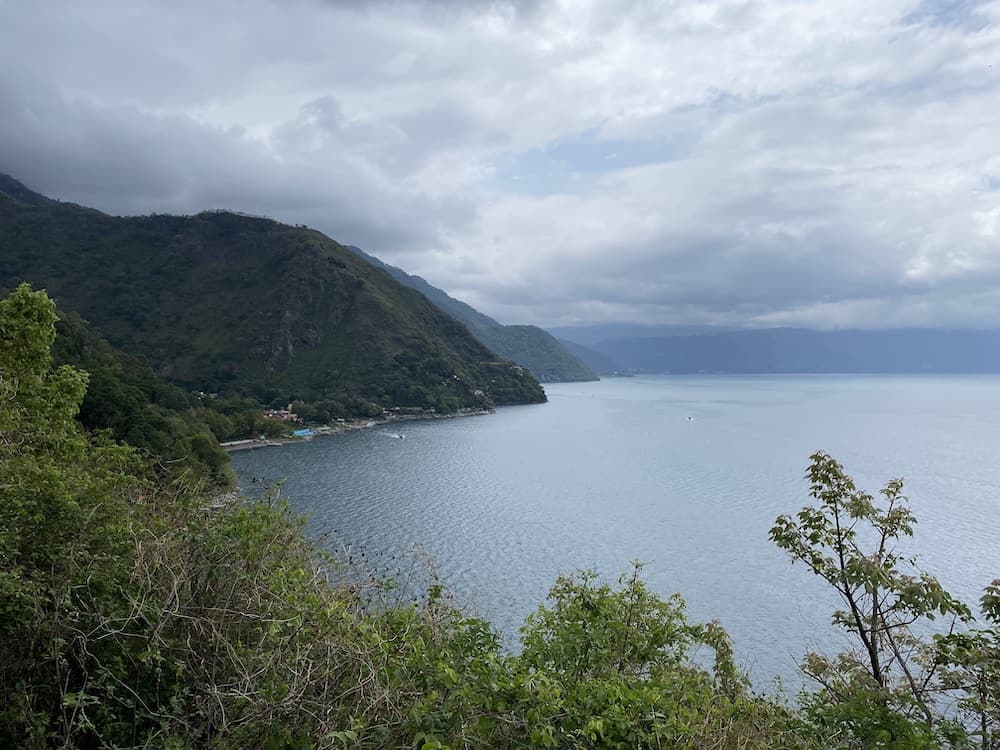
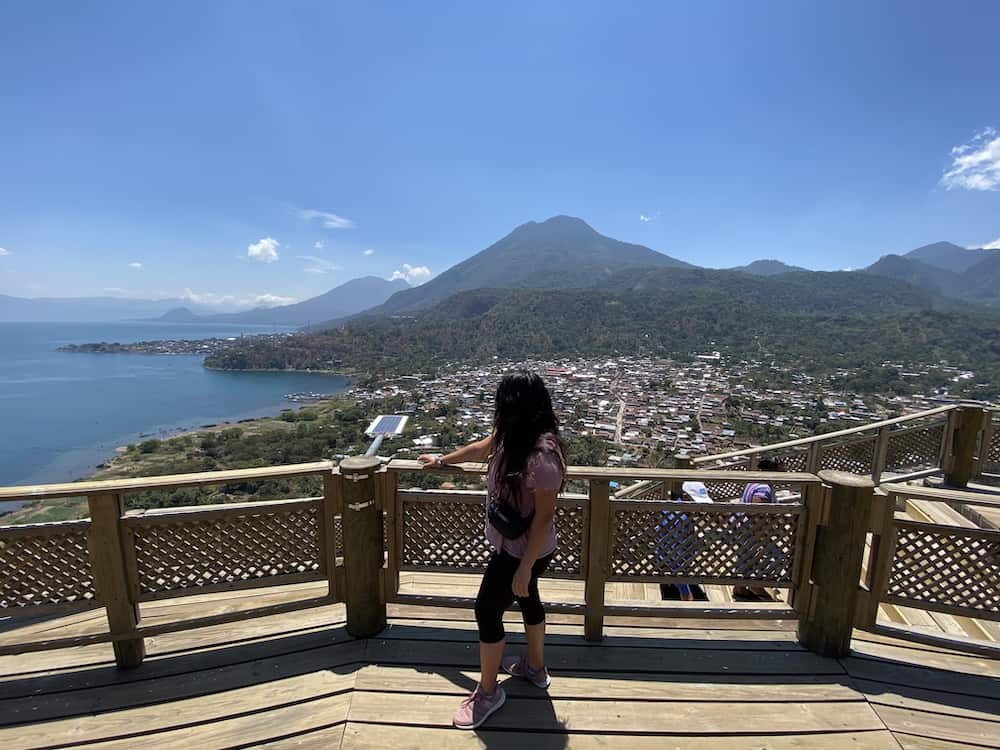

Best Time to Visit Lake Atitlán by Activity
Different activities perform optimally during specific months based on weather patterns and conditions.
Volcano Hiking
Best months: December-March offer dry trails, clear summit views, and cool temperatures ideal for strenuous exertion. Trails stay dry and well-defined. Summit visibility remains excellent for the rewarding views that make the effort worthwhile.
Good months: November and April provide mostly dry conditions with slightly warmer temperatures. Occasional mud on trails is possible but generally manageable.
Challenging months: May-October bring muddy, slippery trails from afternoon rains. Limited summit visibility due to clouds. Afternoon rain cuts hiking windows dramatically—must start very early (5-6am) to summit and descend before storms arrive around 2pm.
For specific volcano recommendations and detailed hiking information, see our complete volcano hiking guide and Indian Nose sunrise guide.
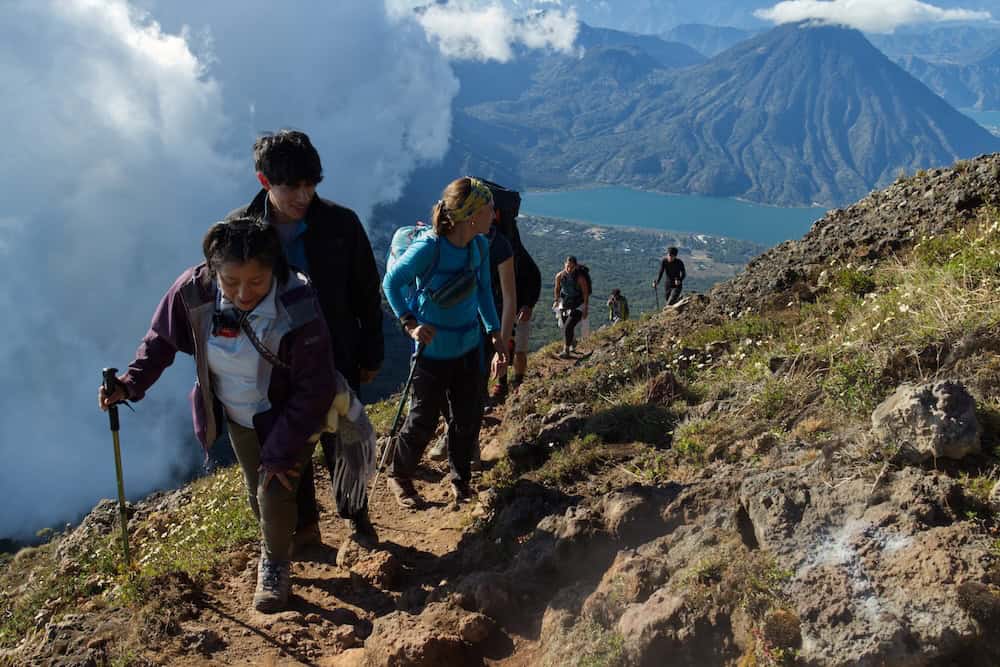
Photography
Best months: January-February deliver crystal-clear skies, perfect volcano visibility, and sharp morning light ideal for landscape photography. No atmospheric haze. Three volcanoes appear dramatically sharp from every angle.
Interesting alternative months: May-June and September-October provide dramatic storm clouds, lush green landscapes, and moody lighting that creates compelling images different from standard sunny lake photos. Post-rain clarity occasionally produces spectacular light.
Best of both worlds: November combines green hills from recent rains with increasingly clear skies—a unique window capturing vibrant landscapes with improving visibility.
Paragliding
Best months: March-April brings the strongest, most consistent winds creating perfect afternoon thermals. Peak season for this activity with reliable conditions daily.
Good months: December-February offer reliable weather and moderate winds sufficient for tandem flights.
Difficult months: May-October present unpredictable conditions with afternoon storms making flights impossible or dangerous. Not recommended during the rainy season.
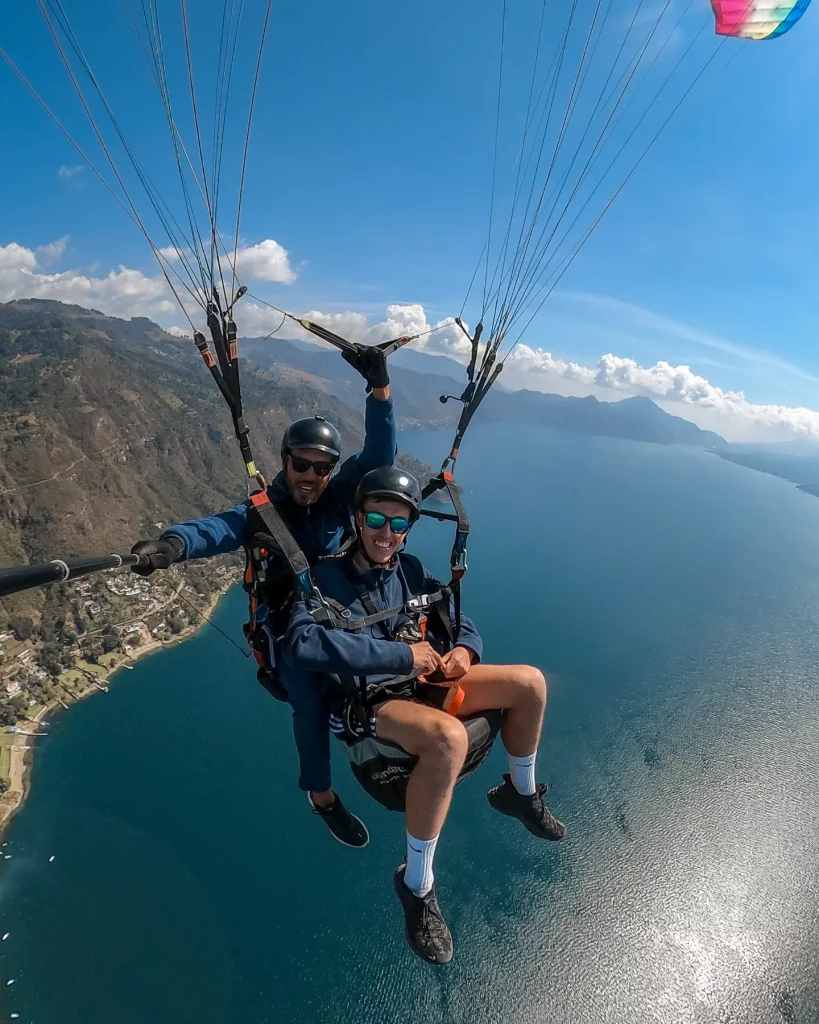
Kayaking
Best months: November-February provide calm waters and clear skies. Morning paddling feels peaceful with glassy water conditions common.
Moderate months: May-October require strict morning kayaking schedules. Avoid afternoons when storms create dangerous conditions with waves and wind. Morning kayaking remains pleasant.
Challenging months: March-April brings strong afternoon winds creating choppy conditions even during dry season. Stick to morning paddles.
Critical safety note: Always kayak in mornings regardless of season. Afternoon winds and storms (depending on season) make lake crossings dangerous for small watercraft.
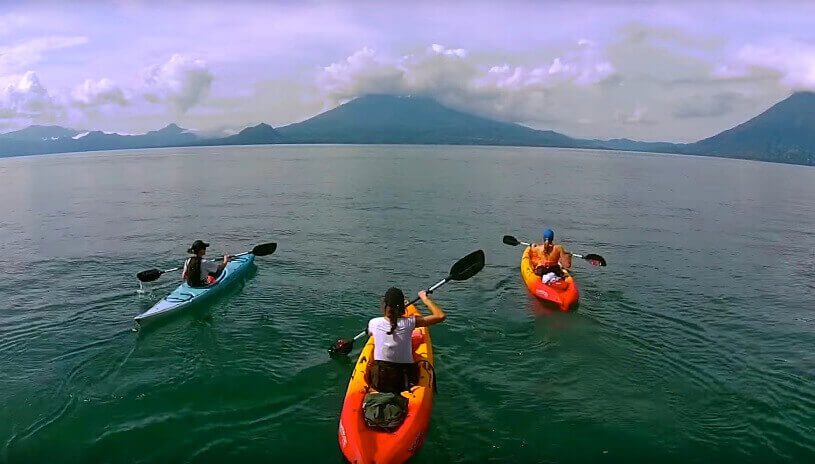
Cultural Activities
Best timing: Year-round. Indoor activities like weaving workshops, cooking classes, and Spanish language schools operate independently of weather conditions.
Rainy season advantage: Fewer tourists mean more personalized attention at workshops and schools. Lower prices for week-long programs.
Market days: Operate year-round every Friday in San Pedro and Friday/Sunday in Santiago Atitlán regardless of weather. Vendors set up covered stalls that function rain or shine.

Yoga & Wellness Retreats
Best months: November-April provide dry season comfort with pleasant weather for outdoor yoga platforms and meditation spaces.
Good alternative: May-October offers lower retreat pricing (sometimes 20-30% below peak), fewer participants creating intimate group sizes, and rain doesn’t affect yoga studios. San Marcos maintains an active yoga community year-round.
Swimming
Best months: March-April offers the warmest water temperatures combined with hot weather making swimming most refreshing.
Good months: May-September continue warm conditions suitable for swimming.
Important note: Always check current water quality before swimming. Algae blooms can occur any time of year. Popular swimming areas near Santa Cruz and San Marcos generally maintain better water quality. Ask locally about current conditions.
For comprehensive activity planning across all seasons, see our adventure planning guide.
Best Time to Visit Based on Your Travel Style
Your traveler type significantly influences optimal timing.
Budget Travelers
Best: May-June or September-October deliver the lowest prices of the year with 30-50% savings on accommodation, often 20-30% lower restaurant prices, and reduced activity costs.
Good: November (especially the first half) maintains reasonable prices while weather improves dramatically.
Avoid: December-February and Semana Santa week represent peak pricing periods.
Families with School-Age Children
Best: December-January or July-August align with standard school vacation periods.
Consider: Semana Santa week if spring break schedules align—book 2-3 months ahead and expect premium pricing.
Reality: Limited flexibility means accepting higher prices during school holiday periods. Focus on finding value within these constrained dates.
First-Time Visitors
Best: January-February or November-December provide reliable weather ensuring all activities function properly and volcano views deliver the spectacular scenery that defines Lake Atitlán.
Good: March or November offer slightly better pricing while maintaining predominantly good weather.
Avoid: September risks disappointment with wettest conditions potentially limiting the experience for visitors with limited time and high expectations.
Photographers
Best: January-February guarantee crystal-clear skies and sharp light ideal for classic landscape photography.
Interesting alternative: May-June or October-November deliver dramatic clouds, lush landscapes, and moody lighting creating different but equally compelling images.
Digital Nomads & Long-Term Visitors
Best: May-October provide low prices for monthly accommodation rentals, fewer tourists creating an authentic atmosphere, and work-friendly rainy afternoons (perfect for inside laptop time).
Good: Shoulder seasons (November, April) balance pricing and weather.
Yoga & Wellness Seekers
Best: Year-round—San Marcos operates continuously with drop-in classes and scheduled retreats.
Optimal for comfort: November-March dry season.
Budget-conscious: May-October retreat prices drop alongside general accommodation costs.
Adventure Travelers
Best: November-March when all activities operate reliably with good conditions.
Peak for paragliding: April despite windiness.
Limited: May-October when rain restricts multi-day adventures and some tour operators reduce schedules.
Crowd Avoiders
Best: May-June or September-October see minimal international tourists—you’ll interact primarily with locals.
Good: November (pre-Thanksgiving) or early December (pre-Christmas) offer good weather with moderate crowds.
Avoid: December 15-January 10 and Semana Santa week bring peak crowds to popular towns.
For detailed planning beyond timing decisions, see our complete travel guide and 3-day itinerary.
What to Pack for Lake Atitlán by Season
Packing appropriately for your travel dates prevents discomfort and unnecessary purchases.
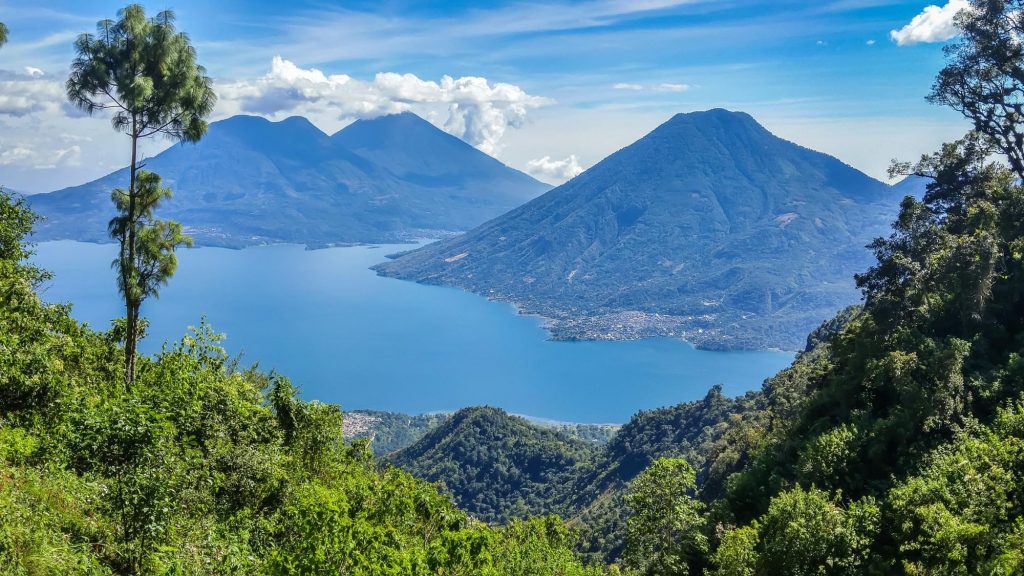
Dry Season (November-April)
- Layers for temperature swings: Light jacket or fleece for cool mornings/evenings (10-15°C), t-shirts for warm afternoons (20-25°C)
- Sun protection: Sunscreen (high-altitude sun is intense), sunglasses, wide-brimmed hat
- Comfortable walking shoes: Dry trails make hiking boots or sturdy sneakers ideal
- Windbreaker: Especially March-April for windy boat crossings
- Camera gear: Perfect photography conditions justify bringing quality equipment
- Light long pants: Cool mornings and modest dress for village visits
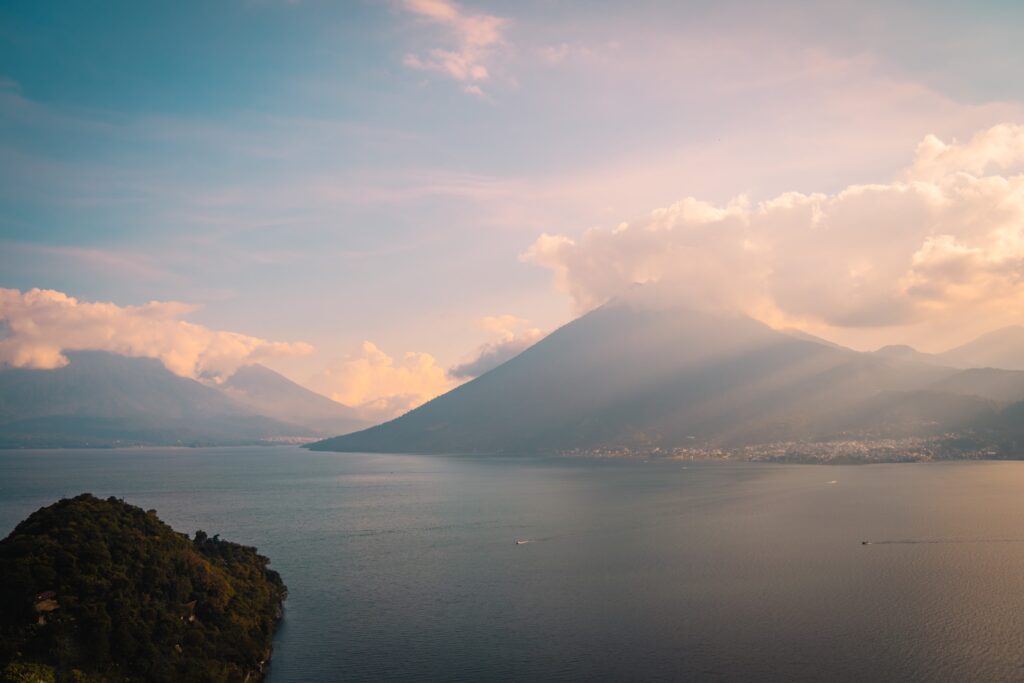
Rainy Season (May-October)
Everything from the dry season list, plus:
- Rain jacket: Lightweight, packable shell essential for afternoon storms
- Quick-dry clothing: Synthetics or merino wool that dry faster than cotton
- Waterproof bag: Protect electronics, passport, money during unexpected downpours
- Closed-toe shoes: Sandals inadequate for muddy conditions; waterproof hiking shoes or boots ideal
- Extra socks: Humidity means laundry takes longer to dry
- Small umbrella: Useful for town walks during light rain
- Patience: Mental preparation for weather-related schedule changes
Year-Round Essentials
- Reusable water bottle: Reduce plastic waste, save money on bottled water
- Daypack: For carrying layers, water, camera during activities
- Swim clothes: If planning to swim—check water quality locally before entering
- Modest clothing: Covered shoulders and knees show respect in indigenous villages
- Cash in small bills: Q20 and Q50 notes for boats, markets, tuk-tuks
- Headlamp or small flashlight: Some towns have limited street lighting after dark
- Basic first aid: Bandaids, pain relievers, altitude sickness medication
What NOT to Pack
- Heavy winter coat: Unnecessary even during coolest months—layers handle temperature variations better
- Excessive clothing: Laundry services available in all major towns for Q30-50 per load
- Formal wear: Lake Atitlán maintains casual atmosphere across all accommodation levels
Packing philosophy: Layers work far better than single heavy items since temperatures vary dramatically from 10°C mornings to 25°C afternoons regardless of season.
Lake Atitlán Festivals and Events Calendar
Timing your visit around festivals adds cultural depth to the experience.
March or April (dates vary annually)
Semana Santa (Holy Week): Guatemala’s biggest holiday period occurring the week before Easter Sunday. Expect spectacular religious processions, intricate sawdust carpets (alfombras) decorating streets, and traditional ceremonies throughout villages. Tourism impact: Massive crowds as Guatemalan families vacation at the lake, accommodation prices spike 50-100%, hotels enforce minimum night stays (3-5 nights), advance booking 2-3 months essential.
May 1
Labor Day: Guatemalan national holiday. Some businesses close, locals travel domestically, moderate impact on tourism.
July 25
Festival of Santiago (Santiago Atitlán): Patron saint celebration featuring traditional Mayan dances, religious processions, fireworks, and festive atmosphere. Best cultural experience opportunity in Santiago all year.
August 15
Assumption of Mary: Religious celebrations occur in various villages with church services and small processions.
October 4
San Francisco (Panajachel): Panajachel’s patron saint day brings local celebrations, though smaller scale than other village festivals.
November 1
Day of the Dead (Día de los Muertos): Families visit cemeteries to honor deceased relatives, giant kites (barriletes gigantes) fly in some highland villages, traditional foods prepare. Beautiful cultural observation opportunity showing deep indigenous traditions.
November 25
Santa Catarina (Santa Catarina Palopó): Small village celebrates patron saint festival with local processions and festivities.
December 8
Immaculate Conception: Religious holiday observed throughout Guatemala.
December 24-25
Christmas (Navidad): Major holiday throughout Guatemala. Many businesses close December 24-26 for family celebrations. Churches hold special midnight masses. Festive atmosphere throughout villages.
December 31-January 1
New Year (Año Nuevo): Peak tourist period with fireworks displays visible across the lake at midnight. Premium accommodation pricing in effect. Parties in tourist-oriented towns like San Pedro.
Important note: Exact dates for some festivals vary yearly. Religious processions and traditional ceremonies happen frequently in indigenous villages beyond these major celebrations. Ask locally about upcoming events during your visit for spontaneous cultural experiences.
Frequently Asked Questions About When to Visit Lake Atitlán
What is the best month to visit Lake Atitlán?
The best months to visit Lake Atitlán are January-February and November-December for optimal weather, or May-June for budget travelers seeking low prices and fewer crowds. January and February offer guaranteed dry weather with clear skies perfect for volcano hiking and photography, though prices run higher and popular towns feel crowded. November and December provide the same excellent weather with fewer tourists if you avoid Christmas holiday weeks. May and June deliver afternoon thunderstorms but sunny mornings, incredibly low prices (30-40% below peak season), and authentic local atmosphere with minimal international tourists.
What is the dry season at Lake Atitlán?
The dry season at Lake Atitlán runs from November through April, with December through March being the driest months experiencing virtually no rainfall. During dry season, expect clear blue skies, excellent volcano visibility, cool mornings (10-15°C / 50-59°F), and warm afternoons (20-25°C / 68-77°F). This represents peak tourist season, bringing higher prices and larger crowds, especially during December-January holidays and Semana Santa (Holy Week) typically in late March or early April.
What is the rainy season like at Lake Atitlán?
The rainy season at Lake Atitlán lasts from May through October, featuring predictable afternoon thunderstorms typically between 2-6pm while mornings remain sunny and perfect for activities. September and October are the wettest months with rain 6-7 days per week, while May and June are milder with showers 3-5 days weekly. Rainy season brings lush green landscapes, dramatically lower prices (30-50% below peak season), and significantly fewer tourists creating more authentic local atmosphere.
Does it rain all day during rainy season at Lake Atitlán?
No, rainy season at Lake Atitlán features afternoon thunderstorms rather than all-day rain. Mornings typically start sunny and beautiful, with clouds building through midday and rain usually falling between 2-6pm. Most storms pass within 1-3 hours. All-day rain is rare, occurring perhaps a few times during the wettest months (September-October). This predictable pattern allows morning activities like volcano hikes, boat rides, and cultural tours, with indoor pursuits like yoga classes, weaving workshops, or relaxing at accommodation during afternoon storms.
When is the cheapest time to visit Lake Atitlán?
The cheapest time to visit Lake Atitlán is September and October when accommodation, food, and tour prices drop 40-50% below peak season rates. May, June, and early November also offer excellent value with prices 30-40% lower than December-February peak season. Budget travelers can find hostel dorm beds for $8-10/night and comfortable private rooms for $25-35/night during these months, compared to $15-20 and $50-80 respectively during peak season. See our complete budget guide for detailed cost breakdowns.
When is Lake Atitlán most crowded?
Lake Atitlán is most crowded from mid-December through early January (Christmas and New Year holidays) and during Semana Santa (Holy Week before Easter, typically late March or early April). During these periods, popular towns like San Pedro and Panajachel feel packed with international tourists and Guatemalan vacationers, accommodation prices spike 50-100%, and advance booking 2-3 months ahead becomes essential. Hotels often enforce minimum night stays of 3-5 nights during these peak weeks.
What is the best time to visit Lake Atitlán for photography?
The best time for photography at Lake Atitlán is January and February when crystal-clear skies provide perfect volcano visibility and sharp morning light ideal for landscape photography. December and early March also deliver excellent conditions. For dramatic storm photography and lush green landscapes, visit May-June or October-November when clearing storms create moody clouds and vibrant vegetation. November offers a unique combination of green hills from recent rains plus increasingly clear skies from the approaching dry season.
Is November a good time to visit Lake Atitlán?
Yes, November is an excellent time to visit Lake Atitlán, particularly the first three weeks. Early November offers the best value—rainy season ending means improving weather, lush green landscapes, low prices (still 30-40% below peak), and minimal crowds. Late November brings perfect dry season weather before December holiday crowds arrive. The only considerations are variable weather early in the month (could see occasional rain showers) and rising prices approaching Thanksgiving week when American travelers increase.
Can you swim in Lake Atitlán year-round?
Swimming in Lake Atitlán is possible year-round, though water temperature and quality vary. March through September offer the warmest conditions when hot weather makes swimming most refreshing. However, always check current water quality before swimming as algae blooms can occur any season. Popular swimming areas near Santa Cruz and San Marcos are generally safe when water conditions are good. Morning swimming works better than afternoons in rainy season before storms arrive.
What is Semana Santa and how does it affect visiting Lake Atitlán?
Semana Santa (Holy Week) is the week before Easter Sunday, typically falling in late March or early April, and represents Guatemala’s biggest holiday period. Lake Atitlán experiences massive crowds as Guatemalan families vacation at the lake, accommodation prices spike 50-100% above normal rates, hotels enforce minimum night stays (3-5 nights), and advance booking 2-3 months ahead becomes essential. The week features beautiful religious processions, sawdust carpets decorating streets, and cultural ceremonies throughout villages. Budget travelers should avoid this week, while those interested in cultural experiences should book far ahead and expect to pay premium prices.
Choosing Your Best Time to Visit Lake Atitlán
No universally “perfect” time exists for visiting Lake Atitlán—only the right time matching your specific priorities and constraints. Weather-focused first-timers should visit December-February despite higher costs for guaranteed sunshine and clear volcano views. Budget travelers thrive during May-October when prices drop 30-50% and sunny mornings still provide excellent activity windows despite afternoon rain. Crowd avoiders find May-June or September-October ideal when international tourists virtually disappear.
November represents the sweet spot combining improving weather, reasonable prices, and moderate crowds—particularly the first two weeks before Thanksgiving. March and April offer good weather at lower prices than winter peak, with the caveat that March-April winds affect boat crossings and Semana Santa brings temporary chaos.
Whatever month you choose, Lake Atitlán delivers authentic cultural experiences, stunning natural beauty, and warm community hospitality year-round. The lake, volcanoes, indigenous villages, and local people welcome visitors every season with genuine warmth.
Get our free Lake Atitlán month-by-month planning checklist delivered to your inbox. Sign up here
Ready to plan your trip? See our complete travel guide for comprehensive information beyond timing decisions.
Find accommodation in San Pedro or Panajachel for your preferred travel dates.Planning group travel with specific timing needs? Contact us for customized scheduling advice considering weather, crowds, and pricing for student groups or retreats.
Related Articles
-

Lake Atitlán Budget Guide 2025: Complete Cost Breakdown for Travelers
-

How to Get to Lake Atitlán: Complete Transportation Guide from Guatemala City & Antigua
-

Where to Stay in Lake Atitlán: Complete Town-by-Town Accommodation Guide
-

Complete Lake Atitlán Travel Guide 2025: Best Towns, Things to Do & Planning Tips

